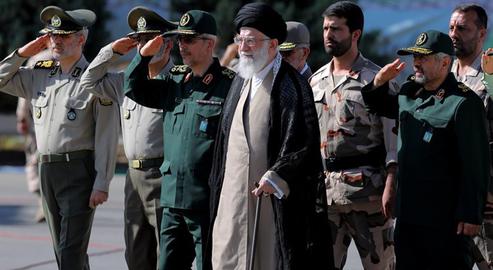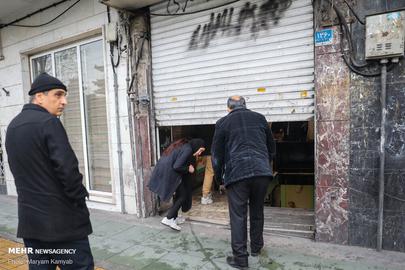Audit reports on Iran’s government budgets – intended to study spending and expose corruption – are usually good reads. In these reports one can find clues to the government’s financial secrets and its violations of the budgets passed by parliament. But compared to past audit reports, what was presented to parliament on the morning of April 14 had few or no precedents.
The budget for March 2018 to March 2019, two years ago, was also unique in its own way. The year began with the withdrawal of the United States from the nuclear agreement. And the budget for the following year, corresponding with March 2019 to March 2020, had seen an economic downturn become a full-fledged crisis. These were two miserably dark years – with organized corruption casting a long shadow over every part of Iran’s economy and politics.
But what was presented by Adel Azar, President of Iran’s Supreme Audit Court, was nothing like the measures taken in the past two years. [Persian PDF] And the budget audit report can provide us with a small measure of clarity on what has been going on behind the scenes in recent years.
A word of warning: the government’s audit report is defective. It does not make any mention of financial corruption in agencies that operate under the supervision of the Supreme Leader, the Revolutionary Guards, the military and the security establishment. But it does at least reveal something of corruption within the government; from illegal salaries and payments to the fate of dollars sold at the (cheap) official price of 4,200 tomans, privatizations, cash subsidies, sweetheart deals between the government and private contractors, and so on.
In this series of reports, IranWire tries to follow the leads provided by the Supreme Audit Court’s audit report. The first report examined corruption in the re-sale of hard currency at official – i.e. the reduced official price and the missing US$5 billion. In this second report we focus on the privatization of state-owned industries and companies.
The Islamic Republic’s Record of Privatization
Article 44 of Iran’s constitution states that the country’s economy consists of three sectors: state, cooperative, and private. On May 22, 2005, Supreme Leader Ayatollah Khamenei issued an order for privatization, entitled “General Policies of Article 44 of the Constitution,” which aimed to accelerate “national economic growth, the promotion of ownership among the general public with the intention of dispensing social justice, increasing the efficiency of economic establishments, boosting competition in the national economy, raising the share of private and cooperative sectors in the national economy, reducing the government's financial commitment and control with regard to economic activities, raising the level of employment in society, encouraging the public to make savings and investments and improving the standards of living.”
On page 9 of the 18-page report by Supreme Audit Court, we read that between 2001 and 2018, a total of 894 state enterprises, worth 149 trillion tomans were privatized. In a report published by IranWire [Persian link] on October 16, 2019, individual instances of privatization were separated out by the year and, by taking inflation into account, the IranWire report concluded that the privatized entities were worth close to US$51 billion (based on the official exchange rate of 4,200 tomans in October 2019).
It is a large number – but only a small part of it can be called “privatization” in the true sense of the word and only then if we disregard small infractions.
The Hollow “Justice Shares”
In 2006, the Iranian cabinet approved a “Justice Shares Distribution Plan” to offer shares, specifically to low-income families as a social justice initiative, in a number of state-owned enterprises that were to be privatized. It was touted, among other things, as a way to lift millions out of poverty. In practice, however, it did not come to anything meaningful.
According to First Vice President Eshagh Jahangiri, 49 million Iranians own these so-called “justice shares” and the value of these shares have grown eight-fold since they were issued. But this increase in value is useless to low-income owners because they are not allowed to sell them. What is more, the dividends are minuscule and restrictions are imposed on the way these are paid. As reported by Iran’s Privatization Organization, in 2018 these shares had a total dividend of just over a trillion tomans, and if this is divided by the 49 million, i.e., the number of shareholders, the share for each stockholder comes to 20 thousand tomans. This means a monthly dividend of around 1,700 tomans (11 cents in today’s open market exchange rate) that cannot even pay for a loaf of bread.
The Biggest Share of the Pie
According to the Supreme Audit Court’s report, around 60 percent of privatized enterprises went to military, security and public institutions such the Social Security Organization. Approximately 21 percent of all privatizations was handed over to non-governmental public institutions as compensation for the money that the government owed them. One of the biggest was the Social Security Organization – which has turned into one of the biggest centers of corruption in Iran.
But the biggest piece of the privatization pie – 38 percent in the past 15 years – went to “retirement funds” and military and security institutions. The share that goes to retirement funds is not entirely clear; however, transferring state-owned enterprises to military and security institutions has been a very lucrative arrangement. By order of the Supreme Leader, these institutions are exempt from paying taxes, which gives them an unfair edge over other sectors of the economy.
Considering that they do not have to pay a 25 percent tax on their net profits, the situation can be compared to a competition where the starting line for a sub-group of contenders is a quarter closer to the finish line than for the rest.
Those “Real” Privatizations
We are left with 21 percent that has been nominally transferred to the private sector, even though this share lies under a dark cloud of corruption and cronyism. It would be enough to look at the privatizations of large companies such as Heavy Equipment Production Company (Hepco) and Haft-Tappeh Sugar Factory to find that even “real privatizations” have been hotbeds of corruption.
Thus far, the Supreme Audit Court’s report has not told us anything new; but there are two entries in the report to which little attention has been paid to date.
The “Irregularities”
The first group of “irregularities” relates to the transfer of state-owned enterprises through negotiations or auctions. According to the report, these irregularities amounted to 1.751 trillion tomans (approximately US$130 million), or eight percent of all privatizations over the past 15 years.
Two-thirds of these irregularities were the result of the way these entities were priced. The report does not tell us about the specific cases, but the process for setting the of enterprises to be privatized has always been suspect. Iran’s Privatization Organization recently published documents on controversial privatizations; but much about the process still rests in the archives of the Privatization Organization, far from the prying eyes of the public.
Irregularities and violations of the law have not been limited to secret deals made behind closed doors. Some violations have been committed quite publicly. According to the Supreme Audit Court’s report, in six cases of privatization, worth 132 billion tomans (close to US$10 million), the law was broken by the transfer of particular enterprises to the directors of those companies. In other words, they did not even take the trouble of using trusted individuals as fronts and the Privatization Organization completely missed such an obvious transgression of the law.
Delayed Instalment Payments
The second subject that is usually overlooked are delayed payments of instalsments for the purchase of state-owned enterprises that have now reached a total of 1.678 trillion tomans – almost $125 million.
“Confiscated” Twice
Since the Islamic Revolution, Iran has gone through two waves of state confiscations of private assets. The first wave came in 1979, when the new government forcibly confiscated private properties belonging to individuals. The second wave started in 2005, when the economic-military mafia, under the banner of “Article 44” of the constitution, set out to plunder public property.
Post-Revolution confiscations are now closed cases; but they have left painful memories of extensive damage done to the Iranian industry.
But the process of so-called privatization is ongoing. When Ayatollah Khamenei issued his new privatization order in 2005, he cited a long list of miracles that he promised would follow, including “national economic growth, the promotion of ownership among the general public with the intention of dispensing social justice,” and so on and so forth. After 15 years, not only has none of these been achieved, but privatization has become an epicenter of corruption and a vicious circle for which Iranian society continues to pay, even as it watches helplessly while national resources and capital are sacrificed and wasted for the benefit of just a few.
Also in the series:
Iran's Missing Dollars; Who Took Them, and How Much?, 16 April 2020
Related Coverage:
The Rise and Fall of Haft-Tappeh Sugar Factory, 22 November 2018
Hepco in Three Acts: The Disaster of Privatization in Iran, 29 May 2018
visit the accountability section
In this section of Iran Wire, you can contact the officials and launch your campaign for various problems


























comments